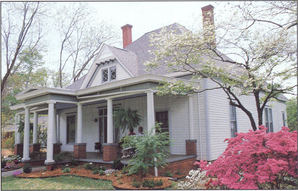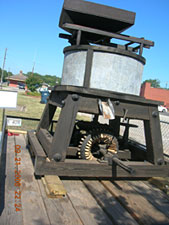 Statham's historic district was entered in the National Register of Historic Places on December 17, 1998. Maps are available at City Hall.
Statham's historic district was entered in the National Register of Historic Places on December 17, 1998. Maps are available at City Hall.
Statham was first known as the Talasee Colony. In this Colony was an Indian Village by the name of Calamit on the Ocoloco Trail, and it was inhabited by the Creek and Cherokee Indians. When the first white settlers came in 1784, they purchased a part of Calamit from the Indian Chief Umausauga for 14 pounds of beads and named it Beadland.
Statham grew from a combination country store and post office owned and operated by Mr. and Mrs. M. J. C. Statham. The post office was first known as Barber's Creek, then DeLay, and changed to Statham in 1892.
The building of the railroad through Statham in 1890 and 1891 marked the beginning of Statham and was the changeover point from a place with a few homes into the creation of a town.
Statham was incorporated on December 20, 1892 and received its first Charter. The incorporated area of the town extends one mile in every direction from the Seaboard Depot which is in the center of town. The first depot was built around 1900. Another depot, which is still standing, was built in 1912.
The first bank in Statham, known as the Statham Bank, was organized in April 1904. To promote and advertise their town, the directors printed interesting facts on the back of the bank envelopes. "Statham is a growing and prosperous town on the Seaboard Air Line Railroad. It has ten mercantile establishments, a hardware and furniture store, drug store, meat market, prosperous bank, excellent hotel, fine dental parlor, two large suction cotton ginneries, cotton warehouse, brick-making plant, livery stables, blacksmith shops, barber shops, three churches and a free public school system."
Due to the coming of the automobile, better roads and the depression of the 1930's, many of the business establishments closed as people began going to larger towns for shopping.
Today Statham is a thriving and growing community of approximately 2,200 citizens. Lifelong residents are being joined by many new families moving into the area.
Fertilizer/Seeder donated to the City of Statham by J. G. Turner and family. The fertilizer/seeder was made by Ontario Drill Company, East Rochester, New York.
Threshing Machine
"Before" pictures of a threshing machine donated to the City by Shirley Segars.
"After" pictures of a threshing machine after it was reworked by city workers and the crew from the I. W. Davis Probation Detention Center. The following tells about the history of the machine:
This machine was purchased by Grady Segars in the mid-1940's after World War II ended. Prior to that time metal equipment was hard to get.
"Mr. Grady" used this thresher to harvest his wheat and also threshed wheat for other farmers. Generally he was paid to harvest for other farmers on "shares." This meant that he received a portion of the grain as payment for the work.
Through the years many men in this area recalled working with the threshing crew. The workers' mid-day meal was furnished by the family they worked for on the site. Some recalled that the meals were good, but they all could recall working for one farm where they were served only green beans and water. They were so hungry!
The machine is given in memory of Jack Segars and all those who worked on the crew.
The Grist Mill
Written by Laura Hammond-Williams
(Great Niece of Mary Hammond Hardigree)
 The Grist Mill was owned by Mary Hammond Hardigree and Luther Hardigree. The story was told by Maurice (Chig) Hammond. The purpose of the grist mill was to grind meal or grits. Stones had to be adjusted to grind each of them. It was in a small building and Chig remembers the sound of putt, putt, putt from the one cylinder motor that was used to run the mill. He said it had belts running in several directions to use the motor for various purposes. One purpose was a corn sheller (possibly a hopper) to shell the corn, and then the stones would crush the corn into meal or grits. Luther had a shingle mill that was run by the same motor. He made wooden shingles to sell for house tops. He had a syrup mill. The motor was used to help squeeze the juice from sugar cane to make the syrup. The juice was in four quart barrels and had mules to go around in circles turning them, while the syrup cooked. Workers would dip the skimmings from the syrup into a tin tub. As it cooked, we (the children) could eat it. If you could not pay for your meal, grits, or syrup grinding, he would take a percentage of it to sell to stores or to sell to others.
The Grist Mill was owned by Mary Hammond Hardigree and Luther Hardigree. The story was told by Maurice (Chig) Hammond. The purpose of the grist mill was to grind meal or grits. Stones had to be adjusted to grind each of them. It was in a small building and Chig remembers the sound of putt, putt, putt from the one cylinder motor that was used to run the mill. He said it had belts running in several directions to use the motor for various purposes. One purpose was a corn sheller (possibly a hopper) to shell the corn, and then the stones would crush the corn into meal or grits. Luther had a shingle mill that was run by the same motor. He made wooden shingles to sell for house tops. He had a syrup mill. The motor was used to help squeeze the juice from sugar cane to make the syrup. The juice was in four quart barrels and had mules to go around in circles turning them, while the syrup cooked. Workers would dip the skimmings from the syrup into a tin tub. As it cooked, we (the children) could eat it. If you could not pay for your meal, grits, or syrup grinding, he would take a percentage of it to sell to stores or to sell to others.
Mary and Luther were the parents of three children: T. B. Hardigree, Roy Hardigree, and Annie Lou Hardigree-Finch. They had ten grandchildren, three of which are living: Faye Hardigree-Bennett, Mary-Ann Finch-Prater, and Elsie Hardigree-Thomas. Seven are deceased: Juliette Hardigree, Lamar Hardigree, Jack Finch, Don Finch, Howard Finch, James (aka Brother) Hardigree, and Randall Hardigree.
The grist mill has been donated by Nathaniel and Linda Hammond-Hall (great-great niece of Mary Hammond-Hardigree) in memory of Mary Hammond-Hardigree, 1884-1935 and Luther Hardigree, 1882-1958, married September 3, 1905.